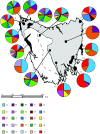MHC gene copy number variation in Tasmanian devils: implications for the spread of a contagious cancer
- PMID: 20219742
- PMCID: PMC2880097
- DOI: 10.1098/rspb.2009.2362
MHC gene copy number variation in Tasmanian devils: implications for the spread of a contagious cancer
Abstract
Tasmanian devils face extinction owing to the emergence of a contagious cancer. Devil facial tumour disease (DFTD) is a clonal cancer spread owing to a lack of major histocompatibility complex (MHC) barriers in Tasmanian devil populations. We present a comprehensive screen of MHC diversity in devils and identify 25 MHC types and 53 novel sequences, but conclude that overall levels of MHC diversity at the sequence level are low. The majority of MHC Class I variation can be explained by allelic copy number variation with two to seven sequence variants identified per individual. MHC sequences are divided into two distinct groups based on sequence similarity. DFTD cells and most devils have sequences from both groups. Twenty per cent of individuals have a restricted MHC repertoire and contain only group I or only group II sequences. Counterintuitively, we postulate that the immune system of individuals with a restricted MHC repertoire may recognize foreign MHC antigens on the surface of the DFTD cell. The implication of these results for management of DFTD and this endangered species are discussed.
Figures

References
-
- Amadou C., Kumanovics A., Jones E. P., Lambracht-Washington D., Yoshino M., Lindahl K. F.1999The mouse major histocompatibility complex: some assembly required. Immunol. Rev. 167, 211–221 (doi:10.1111/j.1600-065X.1999.tb01394.x) - DOI - PubMed
-
- Birch J., Murphy L., MacHugh N. D., Ellis S. A.2006Generation and maintenance of diversity in the cattle MHC Class I region. Immunogenetics 58, 670–679 (doi:10.1007/s00251-006-0137-y) - DOI - PubMed
-
- Cho P. S., et al. 2007Establishment of transplantable porcine tumour cell lines derived from MHC inbred miniature swine. Blood 110, 3996–4004 (doi:10.1182/blood-2007-02-074450) - DOI - PMC - PubMed
-
- DPIW. Save the Tasmanian devil. 2008. See http://www.dpiw.tas.gov.au/inter.nsf/WebPages/LBUN-SQF86?open .
-
- Guiler E.1985Thylacine: the tragedy of the Tasmanian tiger Melbourne, Australia: Oxford University Press
Publication types
MeSH terms
Substances
Associated data
- Actions
- Actions
- Actions
- Actions
- Actions
- Actions
- Actions
- Actions
- Actions
- Actions
- Actions
- Actions
- Actions
- Actions
- Actions
- Actions
- Actions
- Actions
- Actions
- Actions
- Actions
- Actions
- Actions
- Actions
- Actions
- Actions
- Actions
- Actions
- Actions
- Actions
- Actions
- Actions
- Actions
- Actions
- Actions
- Actions
- Actions
- Actions
- Actions
- Actions
- Actions
- Actions
- Actions
- Actions
- Actions
- Actions
- Actions
- Actions
- Actions
- Actions
- Actions
- Actions
- Actions
- Actions
- Actions
- Actions
- Actions
- Actions
- Actions
- Actions
- Actions
- Actions
- Actions
- Actions
- Actions
- Actions
LinkOut - more resources
Full Text Sources
Research Materials

